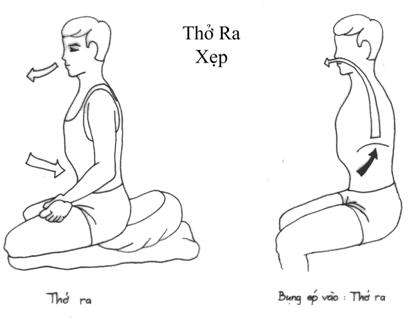Before exploring what breath awareness meditation is, let’s start with the definition of meditation. Meditation is a practice that helps rest the mind, body, and spirit. Notably, meditation based on concentration is increasingly being recognized for its role in preventing and treating illnesses.
Similar to other meditation methods, breath awareness meditation is a technique that focuses on the process of inhaling and exhaling, creating concentration, regulation, and restoring balance to the body.
What is Breath Awareness Meditation?
Breath Awareness Meditation (“Anapanasati” in Pali), grounded in the principles of mindful breathing, serves as a potent technique to bolster concentration, alleviate stress and anxiety, and immerse oneself in stillness.
In this practice, the objective is to center one’s attention singularly on the act of breathing, consciously sidelining the stream of transient thoughts and emotions that permeate the mind.
As one endeavors to focus, the ever-busy mind inevitably ushers in a cascade of thoughts. Rather than succumbing to agitation or frustration, it is imperative that you adopt a stance of acknowledgment. Recognize these thoughts without judgment or attachment, and gently redirect your focus back to the breath.
This cyclical process of acknowledging and redirecting fosters an environment of tranquility and heightened awareness. It is through this deliberate, repeated redirection that you can truly cultivate a serene mind, deeply attuned to the present moment and the rhythmic ebb and flow of breath.
Breath awareness meditation was mentioned by the Buddha in many Nikaya scriptures, such as in the Mahasatipatthana Sutta, where the Buddha teaches:
“Here, bhikkhus, a bhikkhu goes to the forest, to the foot of a tree, or to an empty hut, sits down; having folded his legs crosswise, sets his body erect, and establishes mindfulness in front of him.
Mindful he breathes in, mindful he breathes out.
Breathing in long, he knows ‘I breathe in long’;
Or breathing out long, he knows ‘I breathe out long’;
Breathing in short, he knows ‘I breathe in short’;
Or breathing out short, he knows ‘I breathe out short’;
Experiencing the whole body, I shall breathe in, he trains himself;
Experiencing the whole body, I shall breathe out, he trains himself.
Calming the bodily activity, I shall breathe in, he trains himself;
Calming the bodily activity, I shall breathe out, he trains himself.
Thus he trains himself: ‘I shall breathe in contemplating the body in the body’;
Or he trains himself: ‘I shall breathe out contemplating the body in the body’; or he trains himself: ‘I shall breathe in contemplating the body’s arising nature’; or he trains himself: ‘I shall breathe out contemplating the body’s ceasing nature’; or he trains himself: ‘I shall breathe in contemplating the body’s both arising and ceasing nature’. Being thus mindful, he dwells contemplating the body in the body internally, or externally, or both internally and externally. And he lives independent, not clinging to anything in the world.”
Is Breath Awareness Meditation Suitable for Beginners?
Breath Awareness Meditation is not only suitable for beginners but is often recommended as an initial entry point for those new to meditation practices. LotusBuddhas will give a number of reasons to support this claim:
- Simplicity of technique: Breath Awareness Meditation does not necessitate complex visualization, mantras, or esoteric knowledge. The primary focal point, the breath, is a natural and ever-present phenomenon, making it accessible and uncomplicated for novices.
- Foundation for advanced practices: By cultivating fundamental skills such as concentration and mindfulness, this form of meditation serves as a foundational bedrock. As practitioners become adept at Breath Awareness Meditation, they are better equipped to explore more intricate or specialized meditative techniques.
- Immediate feedback mechanism: The breath provides immediate and continuous feedback. Beginners can easily discern when their attention drifts and develop the discipline of redirecting focus. This tangible aspect of monitoring the breath can be particularly encouraging for those new to meditation, as it provides clear points of focus and realignment.
- Versatility: The non-sectarian nature of Breath Awareness Meditation means it can be adopted by individuals irrespective of their religious or philosophical beliefs. This universality further enhances its appropriateness for a broad spectrum of beginners.
- Documented benefits: Empirical studies have affirmed the potential benefits of Breath Awareness Meditation, even for those with limited experience. Reduction in stress, enhanced concentration, and improved emotional regulation are among the outcomes observed in novice practitioners, underscoring its efficacy for beginners.
As you can see, Breath Awareness Meditation, given its inherent simplicity, foundational nature, and the tangible benefits it offers, is not only suitable but is often recommended as an optimal starting point for individuals embarking on their meditative journey.
Reference more: 8 Best Meditation Techniques for Beginners
How to Practice Breath Awareness Meditation
An essential aspect of meditation is choosing a space. This is no exception for breath awareness meditation. Your meditation space should be cool and comfortable, not too cold like a freezer room nor too hot and stuffy, which can lead to discomfort and agitation.
Besides the location, the sitting posture for breath awareness meditation is also a critical factor that cannot be overlooked. This greatly determines whether your breath and energy can flow smoothly, and whether your soul can be soothed and settled. Follow these points for a proper breath awareness meditation posture:
- Sit in the full lotus position (padmasana), with the right leg on the outside.
- Keep the spine straight.
- Relax the shoulders naturally.
- Straighten the neck, slightly tilting forward.
- Focus your gaze straight ahead and concentrate on a point about 1 meter away.
- Place the tongue against the roof of the mouth and slightly open the mouth.
- Place both hands on each other, in front of the abdomen area, with thumbs touching each other, right hand on top of the left.
1. Awareness of the breath in and out
There are three positions for the practitioner to focus on: the skin at the nostrils, the tip of the nose, and the upper lip. The practitioner must choose one of these three points as a basis for easily recognizing the breath.
With the touch point at the nostrils, when the breath flows in and out, there will be contact with this point, making it easy for the practitioner to notice the breath.
The practitioner should focus on this touch point and recognize the breathing in and out, but should not let the mind follow the breath too deeply into the nose, down to the chest, or to the abdomen. The practitioner should also not let the mind follow the breath too far from the touch point. The practitioner should only be aware of the breath right at that spot. This is similar to focusing on the tip of the nose and the upper lip.
The practitioner should maintain this awareness of the breath in and out throughout the meditation session, during walking meditation, and in all other postures of moving, standing, lying, and sitting. The practice is maintained continuously, without interruption, until the mind becomes soft, skillful, proficient, and unified with the breath, then the sign (nimitta) may appear.
Initially, the practitioner will see the breath as grey like smoke. If the mind is kept calm and stable on the breath, soon this grey will become white like cotton.
If the practitioner continues to maintain a stable meditative mind on the breath, this white will become bright and radiant. The practitioner should note that, although the light may appear in this way, one should not hastily shift attention to observe the light but should continue to focus on recognizing the breath in and out so that the light becomes increasingly bright and intense. However, if the nimitta does not appear, the practitioner should then shift to be aware of the long and short breaths.
2. Awareness of long and short breaths
While keeping the mind at a touch point, either the tip of the nose or the upper lip, the practitioner becomes aware of the breath moving in and out, sometimes long, sometimes short. This is because the duration of the inhalations and exhalations can vary, being fast or slow, coarse or fine, and uneven. By focusing and closely observing, the practitioner will recognize the breaths being short or long.
Maintain a stable and continuous focus on the breath in this way during each sitting period, from one to two hours or as long as possible. At that point, the nimitta might appear. If the nimitta appears, the practitioner should continue focusing on the breath so that the sign becomes stronger and more stable. If the nimitta has not appeared, the practitioner can shift to being aware of the whole body of breath.
3. Awareness of the whole body of breath
Each inhalation or exhalation has three stages: the beginning, the middle, and the end. Because there is heightened awareness to observe the breath in and out completely from start to finish, it is called the sensation of the whole body of breath.
Continue practicing in this way during each sitting period until the mind becomes proficient, discursive thoughts settle down, and the mind no longer wanders to other objects, then the nimitta may appear. As before, the practitioner should not hastily shift attention to the light, but maintain awareness of the breath, then the light will stabilize and grow.
4. Awareness of the calming breath
When mindfulness is continuously maintained on the object, stray thoughts gradually decrease, awareness of the object becomes more focused, and the breath becomes automatically lighter and more peaceful. At this time, the practitioner still observes the breath in and out, whether long or short, or the whole body of the subtle breath.
While meditating on the breath, the practitioner should not verbalize concepts like “in-out,” “long-short,” “whole body,” or “calming.” The practitioner just needs to understand its nature and maintain steady mindfulness on the breath.
The nimitta may appear at any stage when the practitioner skillfully maintains calm and concentration on the breath. When seeing it for the first time, the practitioner should not get overly excited, pleased, or frightened, as this will cause fluctuation in the mind. If the mind fluctuates, then the nimitta will not last. If the practitioner remains calm and maintains steady concentration on the breath, the nimitta will become increasingly bright and merge with the breath. At that time, the practitioner will succeed.
5. Counting the breath
There is another method for practicing breath mindfulness, which is counting the breaths. This method is for those with many discursive thoughts, especially for beginners with many gross fantasies. To apply the counting breaths method:
• Count 1 when the breath goes in and out;
• Count 2 when the breath goes in and out;
Continue counting like this up to 10, then return to counting from 1 to 10 as before. Maintain steady mindfulness on the breath throughout the sitting meditation and all other formal postures until discursive thoughts decrease and practice progresses, then the practitioner should switch to other methods of breath awareness as described above.
Tips for Improving Concentration During Breath Monitoring
Cultivating concentration in Breath Awareness Meditation is much like caring for a tender sapling, demanding your patience, dedication, and a sophisticated grasp of the relationship between outside influences and inner thought processes.
Introducing rituals, such as lighting a candle, carving out a unique meditation space, or commencing with a mantra, serves as a mental cue, prompting your brain to refocus towards meditation.
Allocating a consistent daily time, be it the serene early hours or the peaceful late evening, sharpens the mind’s inherent tendency to focus. Understanding the deep-rooted bond between your body and mind is crucial; thus, maintaining an upright but relaxed posture, emphasizing spinal alignment, enhances alertness and deepens your connection with the breath.
If you struggle with keeping your eyes closed, starting in a subdued setting or gently focusing on a nearby point can help ease you into a more profound closed-eye concentration.
Attuning yourself to the sensory nuances of your breath, like the refreshing feel of the air entering or the rhythmic motion of your chest, acts as a grounding anchor, guiding your attention back whenever your mind wanders. Introducing soft, surrounding sounds, such as tranquil nature tracks or white noise, can create an auditory buffer, shielding you from intermittent disruptions and bolstering consistent focus.
It’s imperative that when distractions arise, rather than yielding to irritation, you should recognize and accept the disturbance as a natural aspect of cognition, and then subtly steer your concentration back to the breath. Integrating a variety of breathing techniques, ranging from deep belly breaths to patterned rhythms, breathes new life into your concentration, providing a distinct point of focus. For those indulging in longer Breath Awareness Meditation sessions, infusing short, intentional breaks can refresh and prime the mind for renewed focus.
Reference more: What to Do When Thoughts Arise During Meditation?
Benefits of Breath Awareness Meditation
Breath Awareness Meditation offers an array of benefits grounded in the simple act of observing one’s breath. Drawing attention to this mundane daily occurrence can yield profound health and well-being benefits, as substantiated by a growing body of scientific evidence.
Considering that a person typically undertakes between 17,000 and 30,000 breaths daily, capitalizing on this routine action holds significant potential. In this next section, LotusBuddhas will tell you the great benefits if you diligently practice Breath Awareness Meditation.
- Enhanced Attention and Focus: In an era marked by pervasive digital distractions, attentional resources are constantly besieged. Alarmingly, contemporary research highlights that the average adult attention span has plummeted over the past 15 years from 12 seconds to a mere 8, rendering it shorter than that of a goldfish. Breath Awareness Meditation serves as an antidote. The omnipresence of the breath offers a readily available anchor point, fortifying one’s ability to concentrate on singular tasks.
- Promotion of Mindful Awareness: Directing attention to one’s breath aligns one with the immediacy of the present moment. Such an act of mindfulness, or present-moment awareness, fosters a direct connection with the unfolding moment. The myriad advantages of enhanced mindfulness encompass diminished stress and an augmented quality of life.
- Conscious Regulation of the Nervous System: The autonomic nervous system underpins vital processes, ensuring our survival. While most of these processes, such as digestion, remain outside conscious control, breathing stands as an exception. One can intentionally modulate inhalation and exhalation. Frequently, focused observation of one’s breath engenders a slowdown, inducing calm. This prolonged, deliberate breathing aligns with the nervous system’s ‘rest and digest’ phase, juxtaposing the heightened ‘fight or flight’ phase.
- Strengthened Mind-Body Synchronization: An intricate interplay exists between the mind and the body. Yet, many individuals predominantly inhabit their cognitive realms, leading to a disconnection from bodily experiences. This disjunction can obscure subtle bodily cues, like fatigue or thirst, which are often overridden with external stimuli like caffeine. However, by consciously observing one’s breath and the associated bodily movements, you nurture an acute awareness of these subtler physical sensations, thereby refining overall bodily consciousness. Preliminary studies even suggest that heightened body awareness bolsters emotion regulation, leading to a more balanced emotional landscape.
In light of these revelations, it becomes abundantly clear that dedicating mere minutes each day to Breath Awareness Meditation is not just beneficial but essential. Through consistent practice, you can cultivate heightened mindfulness, foster calmness, stabilize emotional fluctuations, and sharpen your attentional focus.
By the time you have read this far, you probably have some understanding of what Breath Awareness Meditation is, right? Clearly this is not a mere breathing exercise but a profound adventure into the inner sanctuaries of the human soul. Anchoring the ever-wandering mind into the rhythmic rhythm of the breath acts as a conduit for both self-awareness and the transient nature of our thoughts and emotions. The simplicity of its practice contrasts with its profound depth, for in each inhalation and exhalation is a whole universe of insights waiting to be unearthed.










